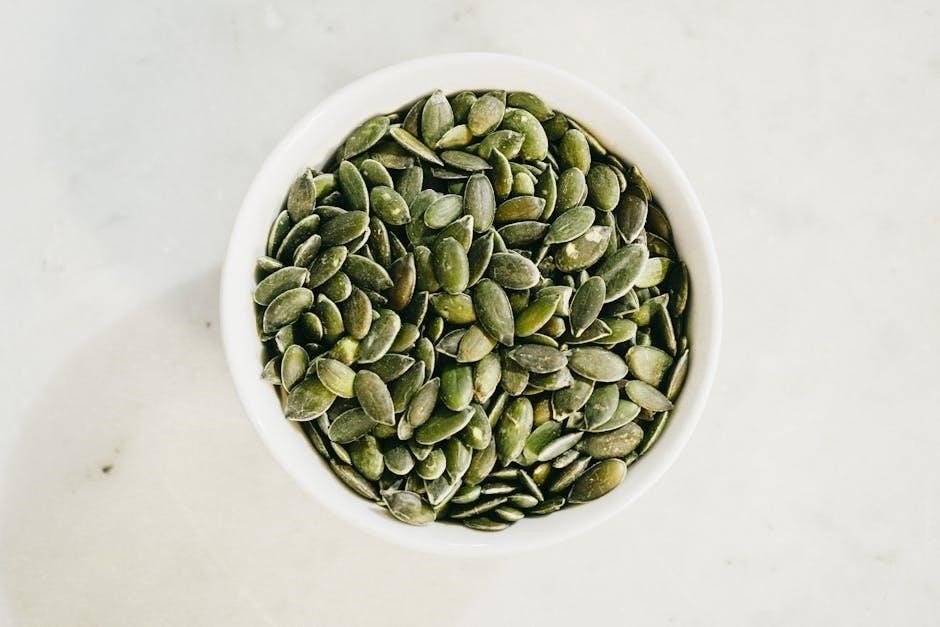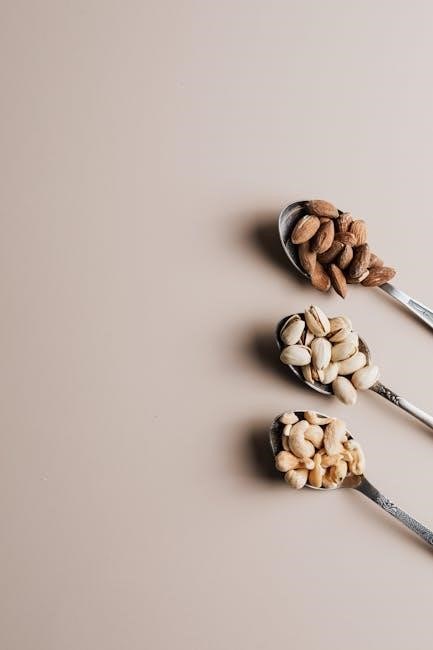A low-fat diet focuses on reducing fat intake to promote weight management and improve health. It emphasizes whole foods like fruits, vegetables, lean proteins, and whole grains, helping lower the risk of chronic diseases while maintaining balanced nutrition.
What is a Low-Fat Diet?
A low-fat diet is an eating plan that limits fat intake, focusing on reducing saturated and trans fats while emphasizing whole, nutrient-rich foods. It prioritizes fruits, vegetables, lean proteins, whole grains, and low-fat dairy products. The goal is to maintain balanced nutrition while lowering overall fat consumption. This approach helps manage weight, improve heart health, and reduce the risk of chronic diseases like diabetes and certain cancers. By choosing foods naturally low in fat, individuals can create a sustainable and healthy dietary pattern. The diet encourages mindful eating and portion control, ensuring a variety of flavors and nutrients without excessive fat. It’s a flexible plan that adapts to personal preferences and dietary needs.
Benefits of a Low-Fat Diet
A low-fat diet offers numerous health benefits, including weight management and improved heart health by reducing saturated fat intake. It lowers cholesterol levels, minimizing the risk of cardiovascular diseases. This dietary approach can help prevent or manage type 2 diabetes and certain cancers. By focusing on nutrient-dense foods, it supports overall well-being and boosts energy levels. Additionally, a low-fat diet encourages healthier eating habits, promoting a balanced intake of essential nutrients; Regular consumption of whole grains, fruits, and vegetables contributes to better digestion and satiety. This diet is also associated with a reduced risk of obesity and fatty liver disease, making it a sustainable choice for long-term health benefits. It’s a practical way to enhance quality of life while maintaining a delicious and varied meal plan.

Food Categories in a Low-Fat Diet
A low-fat diet includes fruits, vegetables, lean proteins, whole grains, and low-fat dairy. These categories provide essential nutrients while minimizing fat intake, supporting overall health.

Fruits and Vegetables
Fruits and vegetables are cornerstone components of a low-fat diet, offering essential vitamins, minerals, and fiber. They are naturally low in fat and calories, making them ideal for weight management and overall health. Incorporate a variety of colorful fruits like apples, oranges, and berries, as well as vegetables such as leafy greens, broccoli, and carrots. These foods provide antioxidants and support digestion. Opt for seasonal produce, like apples in fall or strawberries in spring, to ensure freshness and flavor. Avoid adding fats during preparation, such as frying or adding creamy sauces. Instead, enjoy them raw, steamed, or roasted with herbs for a healthy, low-fat option. These foods not only satisfy hunger but also contribute to a balanced and nutritious diet.
Lean Proteins
Lean proteins are vital in a low-fat diet, providing essential amino acids without excess fat. Opt for poultry like skinless chicken and turkey, and include fish such as salmon and cod, which offer omega-3 benefits. Eggs can be part of your diet, focusing on egg whites or low-cholesterol substitutes. Plant-based options like legumes, lentils, and tofu are excellent sources of protein and fiber. Avoid processed meats and choose lean cuts of beef or pork if consumed. Pairing proteins with herbs and spices enhances flavor without adding fat. Incorporating a variety ensures meals are satisfying and nutritionally balanced, supporting muscle health and overall well-being. These choices align with a low-fat diet, promoting a healthy lifestyle and reducing disease risks.
Whole Grains and Starches
Whole grains and starches are essential in a low-fat diet, offering fiber, vitamins, and minerals. Choose whole grain bread, brown rice, quinoa, and oats for nutrient-rich meals. Opt for refined or whole grain cereals, ensuring they are low in added sugars. Starchy vegetables like potatoes, corn, and peas are also great options. These foods provide sustained energy and support digestive health. When selecting grains, always check labels for “100% whole grain” to avoid refined versions. Incorporate a variety of whole grains and starches into your meals to enhance flavor and nutritional balance while maintaining a low-fat intake. These choices are versatile and can be prepared in ways that align with a healthy, low-fat lifestyle.
Low-Fat Dairy Products
Incorporating low-fat dairy products into your diet supports heart health and satisfies calcium needs. Opt for skim milk, low-fat yogurt, and reduced-fat cheese for balanced nutrition. These options provide essential nutrients without excessive saturated fat. Choose unsweetened, non-fat yogurt to avoid added sugars. When selecting dairy, always check labels for “low-fat” or “fat-free” designations to ensure alignment with your dietary goals. Low-fat dairy products are versatile and can enhance both sweet and savory dishes, offering a creamy texture without the extra fat. Including these in meals aids in maintaining a balanced and satisfying low-fat diet while supporting overall well-being. These choices are ideal for those seeking to manage weight and improve cardiovascular health.
Healthy Fats and Oils
Healthy fats and oils are essential for a balanced low-fat diet, providing vital nutrients and supporting heart health. Incorporate sources like avocados, olives, and unsalted nuts, which offer beneficial monounsaturated and polyunsaturated fats. Olive oil, sunflower oil, and sesame oil are excellent choices for cooking and dressings. These fats enhance meal flavor and aid in absorbing vitamins. When using oils, opt for small portions to maintain calorie balance. Avoid fried foods and processed items high in unhealthy fats. Including these healthy fats in moderation ensures you meet nutritional needs while adhering to a low-fat diet. Always choose unsalted and unprocessed options to maximize health benefits and minimize sodium intake; These fats support overall well-being and contribute to a satisfying diet.

Meal Planning and Grocery Shopping
Plan meals around whole foods like fruits, vegetables, lean proteins, and whole grains. Shop for seasonal produce and low-sodium options, organizing meals to avoid high-fat ingredients.
Breakfast Options
Start your day with nutrient-rich, low-fat breakfast choices. Oatmeal topped with fresh berries or sliced bananas is a great option. Nonfat yogurt paired with granola and fruit offers a balanced mix of protein and fiber. Egg whites scrambled with spinach, mushrooms, or tomatoes provide lean protein without excess fat. Smoothies made with spinach, berries, and low-fat milk are a quick and nutritious choice. Whole-grain cereals with skim milk and a sprinkle of chia seeds are another healthy option. Avocado toast on whole-grain bread with a poached egg or a slice of tomato adds healthy fats in moderation. These options keep you full and energized while aligning with a low-fat diet plan.
Lunch and Dinner Ideas
For lunch and dinner, focus on lean proteins, vegetables, and whole grains. Grilled chicken, turkey, or fish served with steamed vegetables like broccoli, carrots, and green beans make a balanced meal. Salads with mixed greens, cucumbers, tomatoes, and low-fat dressings are also a great option. Quinoa, brown rice, or whole-grain pasta paired with sautéed spinach, mushrooms, and bell peppers add fiber and nutrients. Stir-fries with tofu, lean beef, or shrimp, cooked in minimal oil and loaded with colorful vegetables, are flavorful and healthy. Baked or roasted dishes like vegetable lasagna or stuffed bell peppers with lean ground turkey are satisfying and low in fat. These meals ensure variety and nutrition while staying within a low-fat diet framework.
Snacks and Desserts
Healthy snacking is essential for maintaining energy levels on a low-fat diet. Opt for fresh fruits like apples, bananas, or berries, or vegetables such as baby carrots and cucumber slices. Low-fat yogurt, sorbet, or fruit-based desserts are excellent choices for satisfying sweet cravings. Avoid sugary or high-fat treats like chocolates, pastries, or nuts. Instead, try air-popped popcorn or whole-grain crackers for a crunchy snack. For desserts, consider baked apples or pears, which are naturally sweet and low in fat. These options ensure you stay within your dietary goals while enjoying delicious and nutritious snacks and desserts.
Understanding Food Labels
Check food labels for fat content, focusing on percentages and hidden sources; Look for terms like “low-fat” or “reduced-fat” to make informed, healthy choices easily.
Identifying Low-Fat Foods
Identifying low-fat foods involves checking nutrition labels for fat content. Opt for items with less than 3 grams of fat per serving. Choose lean proteins like skinless chicken or turkey, and select low-fat or fat-free dairy products. Incorporate plenty of fruits and vegetables, which are naturally low in fat. Whole grains and legumes are also excellent choices. Be mindful of hidden fats in processed foods, such as salad dressings or baked goods. Refer to a low-fat diet food list PDF for a comprehensive guide to making healthier selections. This approach helps maintain a balanced diet while reducing overall fat intake effectively.
Hidden Sources of Fat
Hidden sources of fat often lurk in seemingly healthy foods. Processed items like soups, bread, and snacks may contain added fats. Salad dressings, gravies, and fried foods are common culprits. Even low-fat versions of products like mayonnaise or sour cream can contribute to fat intake. Baked goods and sweet treats frequently include butter, oil, or nuts, boosting fat content. Additionally, certain grains and cereals, while wholesome, may have added fats. Consulting a low-fat diet food list PDF can help identify these stealthy sources, enabling better choices and adherence to dietary goals. Awareness is key to avoiding unintended fat consumption and maintaining a balanced, low-fat lifestyle.

Maintaining a Balanced Low-Fat Diet
Maintaining a balanced low-fat diet involves careful meal planning and mindful eating. Focus on whole, nutrient-rich foods like fruits, vegetables, lean proteins, and whole grains. Avoid processed items high in hidden fats. Use a low-fat diet food list PDF to guide your choices, ensuring variety and nutrition. Regular physical activity and portion control further support overall health and weight management, helping you sustain a balanced lifestyle effectively.
Portion Control and Calorie Management
Portion control is crucial for managing calories while following a low-fat diet. Even healthy foods can lead to weight gain if consumed in excess. Use smaller plates and measure portions to avoid overeating. Focus on balancing meals with lean proteins, whole grains, and vegetables. Read food labels to identify calorie and fat content, choosing options with less than 10 grams of fat per serving. Avoid processed snacks and opt for nutrient-dense foods like fruits, nuts, and low-fat dairy. Pairing physical activity with mindful eating helps maintain calorie balance. Refer to a low-fat diet food list PDF for guidance on portion sizes and meal planning. This approach ensures sustainable weight management and overall health.
Long-Term Sustainability
Sustaining a low-fat diet long-term requires practical strategies to maintain enjoyment and prevent boredom. Incorporate a variety of colorful, flavorful foods from your low-fat diet food list PDF to keep meals exciting. Use herbs, spices, and vinegar for flavor instead of fats. Include small portions of satisfying foods like lean proteins and whole grains to avoid feelings of deprivation. Set realistic goals and allow occasional treats to prevent feelings of restriction. Regularly review and adjust your meal plan to ensure it aligns with your lifestyle and preferences. Building a support system and celebrating small achievements can also enhance motivation. By focusing on sustainable habits rather than quick fixes, you can maintain a balanced low-fat diet for years to come.